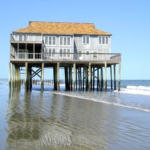The Plum Island Research Project is a team of academic researchers (–Click to Meet the Team–) investigating the long-term history of human and natural changes to Plum Island and the lower Merrimack River Valley. About 45% of the world’s population lives within 100 miles of the coast. This includes nearly 200 cities with populations greater than 50,000, and trillions of dollars worth of infrastructure, all located within 20 feet of modern sea level. Sea level in northern Massachusetts has been rising at various rates for about 13,000 years. Although sea-level rise has been relatively slow over the past several hundred years, there is now overwhelming evidence that the rate of rise is increasing. Rates today are already higher than at any time during the history of modern civilization. There is now scientific consensus that sea level will rise faster and faster throughout coming decades.
At the same time, the supply of sand to beaches from rivers in New England has been decreasing over time. Part of this is natural, due to the removal, by rivers, of loose sediments left behind by massive ice sheets 20,000 years ago. Part of this is due to regrowth of forests following clear cutting during colonial times: trees hold soils in place; the removal of those trees can allow soils to be eroded and the sand and mud in the soils to be transported by rivers to the coast. However, part of this problem is human-induced: sand and mud are trapped behind river dams; sand and gravel are mined on land for concrete for roads and buildings; the natural pathways of transport of sand along the coast has been disturbed through the construction of jetties, groins and seawalls meant to stabilize and protect the coast from erosion.
Our team seeks to understand the impacts of these rising seas and falling supplies of sediment (mud, sand and gravel) to Plum Island and the surrounding marshes and tidal flats. How exactly have the rates of sediment supply to Plum Island changed over the last 10 years? 100 years? 1000 years? Why and what can those long-term records tell us about possible changes in the future? What are the natural cycles of erosion on Plum Island? How have humans contributed to, or changed, these? How will sea-level rise affect them? A large community with associated infrastructure has only existed on Plum Island for about 40 years. What are the sustainable options for the next 40 years as this community seeks to adapt to a changing environment? What are the diverse viewpoints of these changes and potential responses from those who live, work and play on Plum Island and in the surrounding communities?
Our team is composed of coastal geologists, biogeochemists, economists, a historian, and a documentary film maker. We are college professors, students, professionals, scientists and big fans of Plum Island. Together with our partners at the Parker River National Wildlife Refuge, the US Geological Survey, the Merrimack Valley Planning Commission and the Town of Newbury Conservation Commission, we seek to provide the basic scientific information that can help guide management and planning to provide for a long-term sustainable future for the beaches, marshes, communities and wildlife of Plum Island.
The Plum Island Research Project is funded by a grant from the U.S. National Science Foundation Coastal SEES program to the Virginia Institute of Marine Science (College of William and Mary), the University of New Hampshire and Northeastern University.


 Posted: February 18, 2017
Posted: February 18, 2017